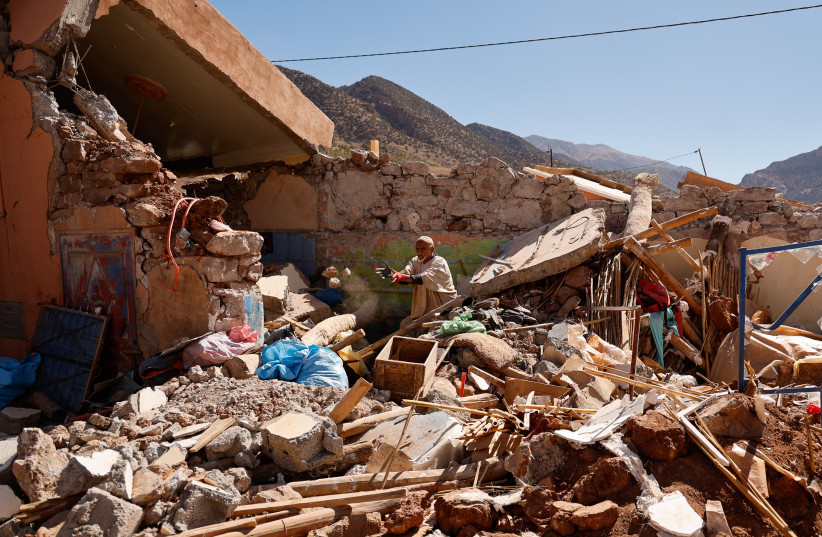On Friday, Sept. 8, at 11.13 pm local time, Morocco was hit by a powerful earthquake with a magnitude of 6.8 on the Richter scale. The epicenter was 73 kilometers (45 miles) south of Marrakesh in the High Atlas Mountains, and the shock could be felt hundreds of kilometers away. More than 3,000 people were killed and over 6,000 injured, and operations continue to extract bodies from the rubble.
For more stories from The Media Line go to themedialine.org
In cities including Rabat, Casablanca, and Kenitra, residents rushed out into the streets, gripped by fear and shock. Moroccans are not used to major earthquakes and were not prepared for this one.
Over the past century, Morocco has experienced two major earthquakes: in 2004 in the coastal city of Al Hoceima, with a magnitude of 6.5 and over 600 deaths, and in Agadir in 1960, with a magnitude of 5.7, causing 12,000 deaths and nearly 25,000 injuries. However, geologists and residents of the region are unanimous in affirming that this was the first earthquake in the High Atlas Mountains for centuries.
The populations of the towns of Al Haouz, Taroudant, Chichaoua, and Azilal experienced terrible anguish immediately after the earthquake, with several residents filming unbearable moments.
As soon as the latest quake hit, the race began to find survivors. The work of the rescue services was complicated by the remote locations of the affected villages and the destroyed roads.

Rebuilding after devastation
I have a very special personal relationship with this part of the kingdom, as this is from where I come. I know very well the names of the douars (small villages) that have unfortunately been wiped off the map. The heavenly landscapes have been transformed into scenes of desolation. Nobody ever thought that one day most of the douars would become rubble.
The earthquake also caused heavy damage to cultural buildings. Experts from the Culture Ministry continue to take stock of the historical monuments affected, dispatching commissions to the various sites. Their mission is to draw up an inventory to study the different reconstruction and restoration scenarios.
According to Jamal Abou Al Houda Abdelmounaim, a curator of monuments and historical sites at the culture directorate in the region of Marrakesh-Safi, several historic Marrakesh buildings have significant cracks, with some requiring total renovation. Restoring the affected sites, including the Bahia Palace, the Kharbouch Mosque, the Kutubiyya Mosque, the Jewish quarter (mellah), the old city ramparts, and the Tinmal Mosque will take years and a large budget.
Dating from the time of the 12th century Almohad dynasty, the Tinmal Mosque is a cultural and religious monument in a douar of the same name, not far from the earthquake's epicenter. The building, listed as a UNESCO cultural heritage site, is near collapse. It underwent rehabilitation in 1998 and was having ongoing repair and enhancement work done by the Culture Ministry.
Starting the day after the earthquake, Royal Moroccan Air Forces helicopters have been carrying out daily combined missions of delivering or dropping aid and evacuating the wounded. To mitigate the terrible effects of the earthquake, the Mohammed V Foundation for solidarity took immediate measures to help the victims. These included putting up emergency tents for people whose homes had been destroyed or seriously damaged.
This great outpouring of solidarity was further illustrated by the endless lines of citizens of all ages and sexes that formed at blood donation centers in various cities set up to help the victims.
In the city of Taroudant and in Asni, a hard-hit rural commune located in the foothills of the High Atlas mountains about 40 kilometers from Marrakesh, the Royal Armed Forces set up medical and surgical field hospitals in less than 48 hours. In the same spirit of solidarity, the Moroccan NGO SOS Children’s Villages set up temporary camps to accommodate children orphaned by the earthquake, as well as single women. A large number of children have found themselves without parents or in precarious situations.
Rescue operations by Moroccan authorities were supported by rescue teams from Spain, the United Kingdom, Qatar, and the United Arab Emirates. According to Richard Brennan, director of the Emergencies Program at the World Health Organization’s Middle East regional office, the health situation in areas affected by the earthquake is “under control.”
In an unprecedented surge of solidarity, donations from public and private companies, NGOs, and individuals have continued to flow in since the announcement of the creation of a Special Fund for Managing Earthquake Effects.
For the affected populations, rehousing is the most urgent need, particularly as winter approaches.
“We would like to see our houses rebuilt as quickly as possible and we will need warm clothes,” said a resident of the village of Amerzegane, where houses were flattened by the earthquake.
On Sept. 14, King Mohammed VI presided over a working meeting with senior authorities at the Royal Palace in Rabat. The meeting was devoted to the activation of an emergency program for the rehousing of disaster victims and the aspects of life most affected by the earthquake.
This meeting came as an extension of the measures ordered by the sovereign, aimed at mobilizing all means, with the necessary speed and efficiency, to come to the aid of affected families and to deploy rehabilitation and reconstruction measures in affected localities as quickly as possible.
Traffic has since been restored on all roads in the province of Taroudant after the disruptions following the earthquake, according to the provincial Directorate of Equipment, Transport, Logistics and Water.
Thanks to the strong mobilization of Moroccans at all levels and their friends around the world, there is hope that some normality will be able to return for the devastated populations of this part of Morocco.
